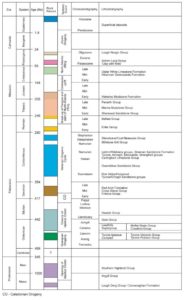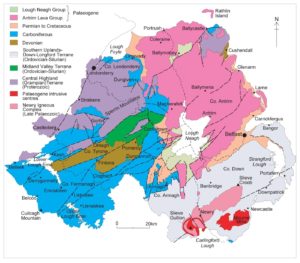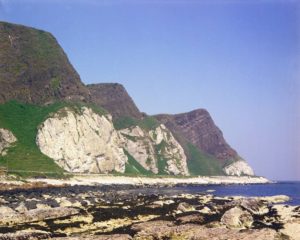18th August 2020
Abstract
A little bit of this… a little bit of that – the Geology of Northern Ireland
Rob Raine – Geological Survey of Northern Ireland
A bit of metamorphic basement—a bit of Ordovician and Silurian shale—a bit of Devonian sediment and lava—some Carboniferous limestone, sandstone, shale and coal—a bit of Permian magnesium limestone, sandstone, mudstone and halite—a bit of Triassic sandstone, mudstone and halite—a bit of Jurassic clay, Cretaceous greensand and chalk—quite a lot of Palaeogene lavas and intrusions—some Oligocene clays… all gouged and smeared by Pleistocene ice sheets. The Geology of Northern Ireland can be described as a bit of a mixture.
When it comes to geological time Northern Ireland seems, more than any other area of Britain and Ireland, to be characterised by non-sequence and unconformity (Figure 1). Conversely, this means that although there is much time with no preserved record, there are rocks from many time periods found across Northern Ireland. This rich variety has led to an interesting patchwork of different rock units, which is beautifully displayed on the geological map (Figure 2) and forms a diverse landscape.
Whilst Northern Ireland shares much of its tectonic and geological history with Scotland, its Late Palaeozoic and younger history differs greatly and compares more closely with offshore basins around Ireland. With the exclusion of the basement, the Phanerozoic geology of Northern Ireland can broadly be divided into four areas that represent different histories of basin formation and uplift (Figure 2). Outcrops of Devonian and Carboniferous rocks are largely restricted to the southwest quadrant. In the northwest quadrant the rocks comprise Dalradian metasediments (Grampian terrane), the Ordovician Tyrone Igneous Complex and the Late Ordovician – early Silurian Pomeroy Inlier. The southeast quadrant is composed of Ordovician and Silurian sediments of the Southern Uplands–Down–Longford terrane, with younger intrusive rocks. The northeast quadrant has Jurassic, Cretaceous and Palaeogene rocks (Figure 3) that blanket thick deposits of Permian and Triassic in largely concealed sedimentary basins. Major Caledonoid southwest – northeast trending faults, with a history of reactivation, both act as boundaries to major structural blocks and subdivide sedimentary basins. NNW-SSE trending faults can be seen to affect the Palaeogene basalts but have an earlier origin. Other subtle N-S and E-W geophysical lineaments point perhaps to deep-seated basement features.
The complexity of Northern Ireland’s geology is a welcome resource for students, a challenge for exploration geologists but now holds the potential to facilitate the move to a low-carbon economy. This talk will provide a potted geological history of Northern Ireland, highlighting some of the major geological events. It will focus on basin formation and what we currently understand of the sedimentary and igneous fill of those basins. Finally it will outline the previous history of exploration for oil and gas, energy storage and geothermal resources in these basins and the direction of future exploration.

Figure 1. Geological Succession of rocks in Northern Ireland (Mitchell 2004)

Figure 2. Simplified geological map of Northern Ireland (Mitchell 2004)

Figure 3. Palaeogene basalt lavas of the Antrim Lava Group overlying the Cretaceous ‘chalk’ (Ulster White Limestone Formation) exposed in the landslip blocks at Garron Point, Co. Antrim. © UKRI.
Sponsor
This event is kindly hosted by:

NO RECORDING AVAILABLE
We have not been granted permission to distribute the recording of this event.
Venue Information
This event will be delivered online.

